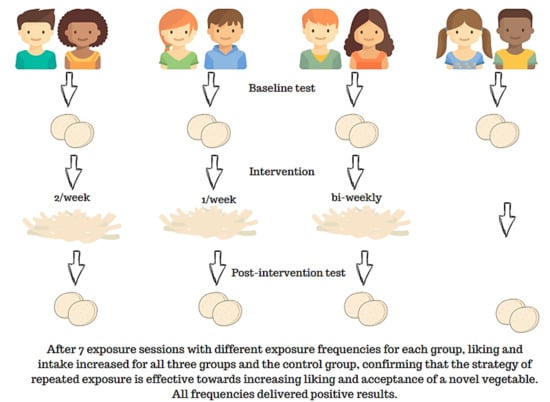Optimising Repeated Exposure: Determining Optimal Exposure Frequency for Introducing a Novel Vegetable among Children
Abstract
1. Introduction
Aim of the Study
2. Materials and Methods
2.1. Study Design
2.2. Recruitment and Participants
2.3. Stimulus
2.4. Visits with Individual Testing
2.5. Intake Visit
2.6. Exposure Visit
2.7. Samples
2.8. Questionnaire
2.9. Data Analysis
3. Results
3.1. Subject Characteristics
3.2. Test Visits
3.2.1. Liking
Control Group
Exposure Groups
3.2.2. Intake
Control Group
Exposure Groups
3.3. Exposure Visits
3.3.1. Exposures 1–4
3.3.2. Exposures 4–7
3.4. Generalisation Effects
4. Discussion
4.1. Exposure Frequency
4.2. Generalisation Effects
4.3. Limitations
5. Conclusions
6. Implications
Supplementary Materials
Author Contributions
Funding
Institutional Review Board Statement
Informed Consent Statement
Data Availability Statement
Conflicts of Interest
References
- Ovesen, L.; Andersen, L.N.; Dragsted, L.O.; Godtfredsen, J.; Haraldsdóttir, J.; Stender, S.; Sølling, K.; Tjønneland, A.; Trolle, E. Frugt, Grønt Og Helbred. Opdatering Af Vidensgrundlaget; Fødevareinstituttet DTU: Søborg, Denmark, 2002. [Google Scholar]
- WHO. Increasing Fruit and Vegetable Consumption to Reduce the Risk of Noncommunicable Diseases; World Health Organization: Geneva, Switzerland, 2017. [Google Scholar]
- Appleton, K.M.; Hemingway, A.; Saulais, L.; Dinnella, C.; Monteleone, E.; Depezay, L.; Morizet, D.; Armando Perez-Cueto, F.J.; Bevan, A.; Hartwell, H. Increasing Vegetable Intakes: Rationale and Systematic Review of Published Interventions. Eur. J. Nutr. 2016, 55, 869–896. [Google Scholar] [CrossRef] [PubMed]
- Astrup, A.; Andersen, N.L.; Stender, S.; Trolle, E. Spis Frugt Og Grønt—6 Om Dagen. In Kostrådene 2005; Ernæringsrådet og Danmarks Fødevareforskning: Søborg, Denmark, 2005; pp. 21–27. [Google Scholar]
- Pedersen, A.N.; Fagt, S.; Groth, M.V.; Christensen, T.; Biltoft-Jensen, A.; Matthiessen, J.; Andersen, N.L.; Kørup, K.; Hartkopp, H.; Ygil, K.H.; et al. Grøntsager Og Grøntsagsprodukter Samt Frugt Og Frugtprodukter. In Danskernes Kostvaner 2003–2008: Hovedresultater; Fødevareinstituttet DTU: Søborg, Denmark, 2010; pp. 30–34. [Google Scholar]
- Norden. Nordic Nutrition Recommendations 2012: Integrating Nutrition and Physical Activity, 5th ed.; Nordisk Ministerråd: Copenhagen, Denmark, 2014. [Google Scholar]
- Fødevarestyrelsen. De Officielle Kostråd—Godt for Sundhed og Klima. Available online: https://altomkost.dk/raad-og-anbefalinger/de-officielle-kostraad-godt-for-sundhed-og-klima/ (accessed on 20 January 2021).
- Svastisalee, C.; Krølner, R.; Pedersen, T.P.; Rasmussen, M. Kostvaner. In Skolebørnsundersøgelsen 2010; Statens Institut for Folkesundhed, Syddansk Universitet: Odense, Denmark, 2011. [Google Scholar]
- Fayet-Moore, F.; McConnell, A.; Cassettari, T.; Tuck, K.; Petocz, P.; Kim, J. Vegetable Intake in Australian Children and Adolescents: The Importance of Consumption Frequency, Eating Occasion and Its Association with Dietary and Sociodemographic Factors. Public Health Nutr. 2020, 23, 474–487. [Google Scholar] [CrossRef] [PubMed]
- Christensen, L.M.; Kørup, K.; Trolle, E.; Matthiessen, J.; Fagt, S. Børn Og Unges Måltidsvaner 2005–2008; DTU Fødevareinstituttet, 2012; Available online: https://backend.orbit.dtu.dk/ws/portalfiles/portal/54035355/rapport_m_ltidsvaner2005_2008_4_19_r_jan.pdf (accessed on 21 January 2021).
- Bowman, S.A.; Gortmaker, S.L.; Ebbeling, C.B.; Pereira, M.A.; Ludwig, D.S. Effects of Fast-Food Consumption on Energy Intake and Diet Quality among Children in a National Household Survey. Pediatrics 2004, 113, 112–118. [Google Scholar] [CrossRef] [PubMed]
- Prentice, A.M.; Jebb, S.A. Fast Foods, Energy Density and Obesity: A Possible Mechanistic Link. Obes. Rev. 2003, 4, 187–194. [Google Scholar] [CrossRef] [PubMed]
- WHO/FAO. Diet, Nutrition and the Prevention of Chronic Diseases; World Health Organization: Geneva, Switzerland, 2003. [Google Scholar]
- Yngve, A.; Wolf, A.; Poortvliet, E.; Elmadfa, I.; Brug, J.; Ehrenblad, B.; Franchini, B.; Haraldsdóttir, J.; Krølner, R.; Maes, L.; et al. Fruit and Vegetable Intake in a Sample of 11-Year-Old Children in 9 European Countries: The Pro Children Cross-Sectional Survey. Ann. Nutr. Metab. 2005, 49, 236–245. [Google Scholar] [CrossRef] [PubMed]
- Blanchette, L.; Brug, J. Determinants of Fruit and Vegetable Consumption among 6–12-Year-Old Children and Effective Interventions to Increase Consumption. J. Hum. Nutr. Diet. 2005, 18, 431–443. [Google Scholar] [CrossRef] [PubMed]
- Reinaerts, E.B.M.; de Nooijer, J.M.; Candel, M.J.J.M.; de Vries, N.K. Explaining School Children’s Fruit and Vegetable Consumption: The Contributions of Availability, Accessibility, Exposure, Parental Consumption and Habit in Addition to Psychosocial Factors. Appetite 2007, 48, 248–258. [Google Scholar] [CrossRef] [PubMed]
- Skinner, J.D.; Carruth, B.R.; Bounds, W.; Ziegler, P.J. Children’s Food Preferences: A Longitudinal Analysis. J. Am. Diet. Assoc. 2002, 102, 1638–1647. [Google Scholar] [CrossRef]
- Birch, L.L. Development of Food Preferences. Annu. Rev. Nutr. 1999, 19, 41–62. [Google Scholar] [CrossRef]
- Zeinstra, G.G.; Koelen, M.A.; Kok, F.J.; de Graaf, C. Cognitive Development and Children’s Perceptions of Fruit and Vegetables; a Qualitative Study. Int. J. Behav. Nutr. Phys. Act. 2007, 4, 30. [Google Scholar] [CrossRef]
- Nicklaus, S.; Boggio, V.; Chabanet, C.; Issanchou, S. A Prospective Study of Food Preferences in Childhood. Food Qual. Prefer. 2004, 15, 805–818. [Google Scholar] [CrossRef]
- Mikkilä, V.; Räsänen, L.; Raitakari, O.T.; Pietinen, P.; Viikari, J. Consistent Dietary Patterns Identified from Childhood to Adulthood: The Cardiovascular Risk in Young Finns Study. Br. J. Nutr. 2005, 93, 923–931. [Google Scholar] [CrossRef] [PubMed]
- te Velde, S.J.; Twisk, J.W.R.; Brug, J. Tracking of Fruit and Vegetable Consumption from Adolescence into Adulthood and Its Longitudinal Association with Overweight. Br. J. Nutr. 2007, 98, 431–438. [Google Scholar] [CrossRef] [PubMed]
- Kaikkonen, J.E.; Mikkilä, V.; Raitakari, O.T. Role of Childhood Food Patterns on Adult Cardiovascular Disease Risk. Curr. Atheroscler. Rep. 2014, 16, 1–15. [Google Scholar] [CrossRef] [PubMed]
- Ambrosini, G.L.; Emmett, P.M.; Northstone, K.; Jebb, S.A. Tracking a Dietary Pattern Associated with Increased Adiposity in Childhood and Adolescence. Obesity 2014, 22, 458–465. [Google Scholar] [CrossRef] [PubMed]
- Havermans, R.C. Increasing Children’s Liking and Intake of Vegetables through Experiential Learning. In Bioactive Foods in Promoting Health; Academic Press: Cambridge, MA, USA, 2009; pp. 273–283. [Google Scholar]
- Cooke, L. The Importance of Exposure for Healthy Eating in Childhood: A Review. J. Hum. Nutr. Diet. 2007, 20, 294–301. [Google Scholar] [CrossRef] [PubMed]
- Lakkakula, A.; Geaghan, J.; Zanovec, M.; Pierce, S.; Tuuri, G. Repeated Taste Exposure Increases Liking for Vegetables by Low-Income Elementary School Children. Appetite 2010, 55, 226–231. [Google Scholar] [CrossRef]
- Anzman-Frasca, S.; Savage, J.S.; Marini, M.E.; Fisher, J.O.; Birch, L.L. Repeated Exposure and Associative Conditioning Promote Preschool Children’s Liking of Vegetables. Appetite 2012, 58, 543–553. [Google Scholar] [CrossRef]
- Zeinstra, G.G.; Vrijhof, M.; Kremer, S. Is Repeated Exposure the Holy Grail for Increasing Children’s Vegetable Intake? Lessons Learned from a Dutch Childcare Intervention Using Various Vegetable Preparations. Appetite 2018, 121, 316–325. [Google Scholar] [CrossRef]
- Nekitsing, C.; Blundell-Birtill, P.; Cockroft, J.E.; Hetherington, M.M. Systematic Review and Meta-Analysis of Strategies to Increase Vegetable Consumption in Preschool Children Aged 2–5 Years. Appetite 2018, 127, 138–154. [Google Scholar] [CrossRef]
- Hausner, H.; Olsen, A.; Møller, P. Mere Exposure and Flavour-Flavour Learning Increase 2–3year-Old Children’s Acceptance of a Novel Vegetable. Appetite 2012, 58, 1152–1159. [Google Scholar] [CrossRef] [PubMed]
- Remy, E.; Issanchou, S.; Chabanet, C.; Nicklaus, S. Repeated Exposure of Infants at Complementary Feeding to a Vegetable Purée Increases Acceptance as Effectively as Flavor-Flavor Learning and More Effectively Than Flavor-Nutrient Learning. J. Nutr. 2013, 143, 1194–1200. [Google Scholar] [CrossRef]
- Wardle, J.; Herrera, M.-L.; Cooke, L.; Gibson, E.L. Modifying Children’s Food Preferences: The Effects of Exposure and Reward on Acceptance of an Unfamiliar Vegetable. Eur. J. Clin. Nutr. 2003, 57, 341–348. [Google Scholar] [CrossRef] [PubMed]
- Mela, D.J. Why Do We like What We Like? J. Sci. Food Agric. 2001, 81, 10–16. [Google Scholar] [CrossRef]
- Feeney, E.L.; O’Brien, S.A.; Scannell, A.G.M.; Markey, A.; Gibney, E.R. Genetic and Environmental Influences on Liking and Reported Intakes of Vegetables in Irish Children. Food Qual. Prefer. 2014, 32, 253–263. [Google Scholar] [CrossRef]
- Nicklaus, S. The Role of Food Experiences during Early Childhood in Food Pleasure Learning. Appetite 2016, 104, 3–9. [Google Scholar] [CrossRef]
- Szczesniak, A.S. Texture Is a Sensory Property. Food Qual. Prefer. 2002, 13, 215–225. [Google Scholar] [CrossRef]
- Sandvik, P.; Laureati, M.; Jilani, H.; Methven, L.; Sandell, M.; Hörmann-Wallner, M.; da Quinta, N.; Zeinstra, G.G.; Almli, V.L. Yuck, This Biscuit Looks Lumpy! Neophobic Levels and Cultural Differences Drive Children’s Check-All-That-Apply (CATA) Descriptions and Preferences for High-Fibre Biscuits. Foods 2020, 10, 21. [Google Scholar] [CrossRef]
- Birch, L.L. Development of Food Acceptance Patterns in the First Years of Life. Proc. Nutr. Soc. 1998, 57, 617–624. [Google Scholar] [CrossRef]
- Falciglia, G.A.; Couch, S.C.; Gribble, L.S.; Pabst, S.M.; Frank, R. Food Neophobia in Childhood Affects Dietary Variety. J. Am. Diet. Assoc. 2000, 100, 1474–1481. [Google Scholar] [CrossRef]
- Carruth, B.R.; Skinner, J.; Houck, K.; Moran, J.; Coletta, F.; Ott, D. The Phenomenon of “Picky Eater”: A Behavioral Marker in Eating Patterns of Toddlers. J. Am. Coll. Nutr. 1998, 17, 180–186. [Google Scholar] [CrossRef] [PubMed]
- Cooke, L.; Wardle, J.; Gibson, E.L. Relationship between Parental Report of Food Neophobia and Everyday Food Consumption in 2–6-Year-Old Children. Appetite 2003, 41, 205–206. [Google Scholar] [CrossRef]
- Cooke, L.; Carnell, S.; Wardle, J. Food Neophobia and Mealtime Food Consumption in 4–5 Year Old Children. Int. J. Behav. Nutr. Phys. Act. 2006, 3, 14. [Google Scholar] [CrossRef] [PubMed]
- Cooke, L.J.; Wardle, J.; Gibson, E.; Sapochnik, M.; Sheiham, A.; Lawson, M. Demographic, Familial and Trait Predictors of Fruit and Vegetable Consumption by Pre-School Children. Public Health Nutr. 2004, 7, 295–302. [Google Scholar] [CrossRef] [PubMed]
- Galloway, A.T.; Lee, Y.; Birch, L.L. Predictors and Consequences of Food Neophobia and Pickiness in Young Girls. J. Am. Diet. Assoc. 2003, 103, 692–698. [Google Scholar] [CrossRef] [PubMed]
- Russell, C.G.; Worsley, A. A Population-Based Study of Preschoolers’ Food Neophobia and Its Associations with Food Preferences. J. Nutr. Educ. Behav. 2008, 40, 11–19. [Google Scholar] [CrossRef] [PubMed]
- Siegrist, M.; Hartmann, C.; Keller, C. Antecedents of Food Neophobia and Its Association with Eating Behavior and Food Choices. Food Qual. Prefer. 2013, 30, 293–298. [Google Scholar] [CrossRef]
- Taylor, C.M.; Wernimont, S.M.; Northstone, K.; Emmett, P.M. Picky/Fussy Eating in Children: Review of Definitions, Assessment, Prevalence and Dietary Intakes. Appetite 2015, 95, 349–359. [Google Scholar] [CrossRef] [PubMed]
- Haszard, J.J.; Skidmore, P.M.L.; Williams, S.M.; Taylor, R.W. Associations between Parental Feeding Practices, Problem Food Behaviours and Dietary Intake in New Zealand Overweight Children Aged 4–8 Years. Public Health Nutr. 2015, 18, 1036–1043. [Google Scholar] [CrossRef] [PubMed]
- Galloway, A.T.; Fiorito, L.; Lee, Y.; Birch, L.L. Parental Pressure, Dietary Patterns, and Weight Status among Girls Who Are ‘Picky Eaters’. J. Am. Diet. Assoc. 2005, 105, 541–548. [Google Scholar] [CrossRef]
- Dubois, L.; Farmer, A.P.; Girard, M.; Peterson, K. Preschool Children’s Eating Behaviours Are Related to Dietary Adequacy and Body Weight. Eur. J. Clin. Nutr. 2007, 61, 846–855. [Google Scholar] [CrossRef] [PubMed]
- Tharner, A.; Jansen, P.W.; Kiefte-de Jong, J.C.; Moll, H.A.; van der Ende, J.; Jaddoe, V.W.V.; Hofman, A.; Tiemeier, H.; Franco, O.H. Toward an Operative Diagnosis of Fussy/Picky Eating: A Latent Profile Approach in a Population-Based Cohort. Int. J. Behav. Nutr. Phys. Act. 2014, 11, 14. [Google Scholar] [CrossRef]
- Howard, A.J.; Mallan, K.M.; Byrne, R.; Magarey, A.; Daniels, L.A. Toddlers’ Food Preferences. The Impact of Novel Food Exposure, Maternal Preferences and Food Neophobia. Appetite 2012, 59, 818–825. [Google Scholar] [CrossRef]
- Evans, C.E.L.; Hutchinson, J.; Christian, M.S.; Hancock, N.; Cade, J.E. Measures of Low Food Variety and Poor Dietary Quality in a Cross-Sectional Study of London School Children. Eur. J. Clin. Nutr. 2018, 72, 1497–1505. [Google Scholar] [CrossRef] [PubMed]
- Taylor, C.M.; Northstone, K.; Wernimont, S.M.; Emmett, P.M. Macro- and Micronutrient Intakes in Picky Eaters: A Cause for Concern? Am. J. Clin. Nutr. 2016, 104, 1647–1656. [Google Scholar] [CrossRef] [PubMed]
- Raudenbush, B.; Capiola, A. Physiological Responses of Food Neophobics and Food Neophilics to Food and Non-Food Stimuli. Appetite 2012, 58, 1106–1108. [Google Scholar] [CrossRef] [PubMed]
- Kral, T.V.E. Food Neophobia and Its Association with Diet Quality and Weight Status in Children. In Food Neophobia: Behavioral and Biological Influences; Elsevier: Amsterdam, The Netherlands, 2018; pp. 287–303. [Google Scholar]
- Perry, R.A.; Mallan, K.M.; Koo, J.; Mauch, C.E.; Daniels, L.A.; Magarey, A.M. Food Neophobia and Its Association with Diet Quality and Weight in Children Aged 24 Months: A Cross Sectional Study. Int. J. Behav. Nutr. Phys. Act. 2015, 12, 13. [Google Scholar] [CrossRef] [PubMed]
- Finistrella, V.; Manco, M.; Ferrara, A.; Rustico, C.; Presaghi, F.; Morino, G. Cross-Sectional Exploration of Maternal Reports of Food Neophobia and Pickiness in Preschooler-Mother Dyads. J. Am. Coll. Nutr. 2012, 31, 152–159. [Google Scholar] [CrossRef] [PubMed]
- Kaar, J.L.; Shapiro, A.L.B.; Fell, D.M.; Johnson, S.L. Parental Feeding Practices, Food Neophobia, and Child Food Preferences: What Combination of Factors Results in Children Eating a Variety of Foods? Food Qual. Prefer. 2016, 50, 57–64. [Google Scholar] [CrossRef]
- Gregory, J.E.; Paxton, S.J.; Brozovic, A.M. Maternal Feeding Practices, Child Eating Behaviour and Body Mass Index in Preschool-Aged Children: A Prospective Analysis. Int. J. Behav. Nutr. Phys. Act. 2010, 7, 1–10. [Google Scholar] [CrossRef] [PubMed]
- Smith, A.D.; Herle, M.; Fildes, A.; Cooke, L.; Steinsbekk, S.; Llewellyn, C.H. Food Fussiness and Food Neophobia Share a Common Etiology in Early Childhood. J. Child Psychol. Psychiatry 2017, 58, 189–196. [Google Scholar] [CrossRef]
- Nicklaus, S.; Monnery-Patris, S. Food Neophobia in Children and Its Relationships with Parental Feeding Practices/Style. In Food Neophobia: Behavioral and Biological Influences; Elsevier: Amsterdam, The Netherlands, 2018; pp. 255–286. [Google Scholar]
- Moding, K.J.; Stifter, C.A. Temperamental Approach/Withdrawal and Food Neophobia in Early Childhood: Concurrent and Longitudinal Associations. Appetite 2016, 107, 654–662. [Google Scholar] [CrossRef]
- Rothbart, M.K.; Ahadi, S.A.; Hershey, K.L.; Fisher, P. Investigations of Temperament at Three to Seven Years: The Children’s Behavior Questionnaire. Child Dev. 2003, 72, 1394–1408. [Google Scholar] [CrossRef]
- Rigal, N.; Rubio, B.; Monnery-Patris, S. Is Harsh Caregiving Effective in Toddlers with Low Inhibitory Control? An Experimental Study in the Food Domain. Infant Behav. Dev. 2016, 43, 5–12. [Google Scholar] [CrossRef]
- Zajonc, R.B. Mere Exposure: A Gateway to the Subliminal. Curr. Dir. Psychol. Sci. 2001, 10, 224–228. [Google Scholar] [CrossRef]
- Laureati, M.; Bergamaschi, V.; Pagliarini, E. School-Based Intervention with Children. Peer-Modeling, Reward and Repeated Exposure Reduce Food Neophobia and Increase Liking of Fruits and Vegetables. Appetite 2014, 83, 26–32. [Google Scholar] [CrossRef] [PubMed]
- Kutbi, H.A.; Alhatmi, A.A.; Alsulami, M.H.; Alghamdi, S.S.; Albagar, S.M.; Mumena, W.A.; Mosli, R.H. Food Neophobia and Pickiness among Children and Associations with Socioenvironmental and Cognitive Factors. Appetite 2019, 142, 104373. [Google Scholar] [CrossRef] [PubMed]
- Zajonc, R. Attitudinal Effects of Mere Exposure. J. Pers. Soc. Psychol. 1968, 9, 1–27. [Google Scholar] [CrossRef]
- Mura Paroche, M.; Caton, S.J.; Vereijken, C.M.J.L.; Weenen, H.; Houston-Price, C. How Infants and Young Children Learn About Food: A Systematic Review. Front. Psychol. 2017, 8, 1046. [Google Scholar] [CrossRef] [PubMed]
- Maier, A.; Chabanet, C.; Schaal, B.; Issanchou, S.; Leathwood, P. Effects of Repeated Exposure on Acceptance of Initially Disliked Vegetables in 7-Month Old Infants. Food Qual. Prefer. 2007, 18, 1023–1032. [Google Scholar] [CrossRef]
- Wadhera, D.; Capaldi Phillips, E.D.; Wilkie, L.M. Teaching Children to like and Eat Vegetables. Appetite 2015, 93, 75–84. [Google Scholar] [CrossRef] [PubMed]
- Osborne, C.L.; Forestell, C.A. Increasing Children’s Consumption of Fruit and Vegetables: Does the Type of Exposure Matter? Physiol. Behav. 2012, 106, 362–368. [Google Scholar] [CrossRef] [PubMed]
- Ahern, S.M.; Caton, S.J.; Bouhlal, S.; Hausner, H.; Olsen, A.; Nicklaus, S.; Møller, P.; Hetherington, M.M. Eating a Rainbow. Introducing Vegetables in the First Years of Life in 3 European Countries. Appetite 2013, 71, 48–56. [Google Scholar] [CrossRef]
- Grimm, K.A.; Kim, S.A.; Yaroch, A.L.; Scanlon, K.S. Fruit and Vegetable Intake During Infancy and Early Childhood. Pediatrics 2014, 134, S63–S69. [Google Scholar] [CrossRef]
- Gregory, J.E.; Paxton, S.J.; Brozovic, A.M. Maternal Feeding Practices Predict Fruit and Vegetable Consumption in Young Children. Results of a 12-Month Longitudinal Study. Appetite 2011, 57, 167–172. [Google Scholar] [CrossRef]
- Bornstein, R.F.; Kale, A.R.; Cornell, K.R. Boredom as a Limiting Condition on the Mere Exposure Effect. J. Pers. Soc. Psychol. 1990, 58, 791–800. [Google Scholar] [CrossRef]
- Köster, E.P.; Mojet, J. Familiarity, Monotony, or Variety: The Role of Flavor Complexity in Food Intake. In Flavor: From Food to Behaviors, Wellbeing and Health; Elsevier: Amsterdam, The Netherlands, 2016; pp. 277–291. [Google Scholar]
- Keller, K.L. The Use of Repeated Exposure and Associative Conditioning to Increase Vegetable Acceptance in Children: Explaining the Variability Across Studies. J. Acad. Nutr. Diet. 2014, 114, 1169–1173. [Google Scholar] [CrossRef] [PubMed]
- Ahern, S.M.; Caton, S.J.; Blundell, P.; Hetherington, M.M. The Root of the Problem: Increasing Root Vegetable Intake in Preschool Children by Repeated Exposure and Flavour Flavour Learning. Appetite 2014, 80, 154–160. [Google Scholar] [CrossRef] [PubMed]
- Birch, L.L.; Gunder, L.; Grimm-Thomas, K.; Laing, D.G. Infants’ Consumption of a New Food Enhances Acceptance of Similar Foods. Appetite 1998, 30, 283–295. [Google Scholar] [CrossRef] [PubMed]
- Shutts, K.; Kinzler, K.D.; DeJesus, J.M. Understanding Infants’ and Children’s Social Learning about Foods: Previous Research and New Prospects. Dev. Psychol. 2013, 49, 419–425. [Google Scholar] [CrossRef] [PubMed]
- Salvy, S.-J.; Pliner, P. Social Influences on Eating in Children and Adults. In Obesity Prevention; Elsevier Inc.: Amsterdam, The Netherlands, 2010; pp. 617–627. [Google Scholar]
- Estay, K.; Pan, S.; Zhong, F.; Capitaine, C.; Guinard, J.-X. A Cross-Cultural Analysis of Children’s Vegetable Preferences. Appetite 2019, 142, 104346. [Google Scholar] [CrossRef]
- Saxholt, E.; Christensen, A.T.; Møller, A.; Hartkopp, H.B.; Hess Ygil, K.; Hels, O.H. Fødevarerdatabanken Version 7.01; Afdeling for Ernæring, Fødevareinstituttet DTU: Søborg, Denmark, 2009. [Google Scholar]
- Christensen, L.P.; Edelenbos, M.; Kreutzmann, S. Fruits and Vegetables of Moderate Climate. In Flavours Fragrances; Springer: Berlin/Heidelberg, Germany, 2007; pp. 169–172. [Google Scholar]
- McGee, H. A Survey of Common Vegetables. In McGee on Food and Cooking, an Encyclopedia of Kitchen Science, History and Culture; Hodder and Stoughton: London, UK, 2004; pp. 309–310, 320–324, 328. [Google Scholar]
- Olsen, A.; Ritz, C.; Kraaij, L.W.; Møller, P. Children’s Liking and Intake of Vegetables: A School-Based Intervention Study. Food Qual. Prefer. 2012, 23, 90–98. [Google Scholar] [CrossRef]
- Olsen, A.; Ritz, C.; Kramer, L.; Møller, P. Serving Styles of Raw Snack Vegetables. What Do Children Want? Appetite 2012, 59, 556–562. [Google Scholar] [CrossRef] [PubMed]
- Popper, R.; Kroll, J.J. Consumer Testing of Food Products Using Children. In Developing Children’s Food Products; Elsevier: Amsterdam, The Netherlands, 2011; pp. 163–187. [Google Scholar]
- Holley, C.E.; Haycraft, E.; Farrow, C. ‘Why Don’t You Try It Again?’ A Comparison of Parent Led, Home Based Interventions Aimed at Increasing Children’s Consumption of a Disliked Vegetable. Appetite 2015, 87, 215–222. [Google Scholar] [CrossRef] [PubMed]
- Maxwell, A.E.; Castillo, L.; Arce, A.A.; De Anda, T.; Martins, D.; McCarthy, W.J. Eating Veggies Is Fun! An Implementation Pilot Study in Partnership with a YMCA in South Los Angeles. Prev. Chronic Dis. 2018, 15, E132. [Google Scholar] [CrossRef] [PubMed]
- Zeinstra, G.G.; Renes, R.J.; Koelen, M.A.; Kok, F.J.; de Graaf, C. Offering Choice and Its Effect on Dutch Children’s Liking and Consumption of Vegetables: A Randomized Controlled Trial. Am. J. Clin. Nutr. 2010, 91, 349–356. [Google Scholar] [CrossRef] [PubMed]
- Wardle, J.; Guthrie, C.A.; Sanderson, S.; Rapoport, L. Development of the Children’s Eating Behaviour Questionnaire. J. Child Psychol. Psychiatry 2001, 42, 963–970. [Google Scholar] [CrossRef] [PubMed]
- Musher-Eizenman, D.; Holub, S. Comprehensive Feeding Practices Questionnaire: Validation of a New Measure of Parental Feeding Practices. J. Pediatr. Psychol. 2007, 32, 960–972. [Google Scholar] [CrossRef]
- Pliner, P. Development of Measures of Food Neophobia in Children. Appetite 1994, 23, 147–163. [Google Scholar] [CrossRef] [PubMed]
- Jose, P.; Bates, D.; DebRoy, S.; Sarkar, D.; R Core Team. {nlme}: Linear and Nonlinear Mixed Effects Models; Springer: New York, NY, USA, 2018. [Google Scholar]
- Hothorn, T.; Bretz, F.; Westfall, P. Simultaneous Inference in General Parametric Models. Biometrical J. 2008, 50, 346–363. [Google Scholar] [CrossRef]
- De Wild, V.W.T.; de Graaf, C.; Jager, G. Effectiveness of Flavour Nutrient Learning and Mere Exposure as Mechanisms to Increase Toddler’s Intake and Preference for Green Vegetables. Appetite 2013, 64, 89–96. [Google Scholar] [CrossRef] [PubMed]
- Caton, S.J.; Ahern, S.M.; Remy, E.; Nicklaus, S.; Blundell, P.; Hetherington, M.M. Repetition Counts: Repeated Exposure Increases Intake of a Novel Vegetable in UK Pre-School Children Compared to Flavour–Flavour and Flavour–Nutrient Learning. Br. J. Nutr. 2013, 109, 2089–2097. [Google Scholar] [CrossRef]
- Bouhlal, S.; Issanchou, S.; Chabanet, C.; Nicklaus, S. ‘Just a Pinch of Salt’. An Experimental Comparison of the Effect of Repeated Exposure and Flavor-Flavor Learning with Salt or Spice on Vegetable Acceptance in Toddlers. Appetite 2014, 83, 209–217. [Google Scholar] [CrossRef]
- de Wild, V.; de Graaf, C.; Jager, G. Efficacy of Repeated Exposure and Flavour–Flavour Learning as Mechanisms to Increase Preschooler’s Vegetable Intake and Acceptance. Pediatr. Obes. 2015, 10, 205–212. [Google Scholar] [CrossRef]
- de Wild, V.W.T.; de Graaf, C.; Jager, G. Use of Different Vegetable Products to Increase Preschool-Aged Children’s Preference for and Intake of a Target Vegetable: A Randomized Controlled Trial. J. Acad. Nutr. Diet. 2017, 117, 859–866. [Google Scholar] [CrossRef] [PubMed]
- Nederkoorn, C.; Theiβen, J.; Tummers, M.; Roefs, A. Taste the Feeling or Feel the Tasting: Tactile Exposure to Food Texture Promotes Food Acceptance. Appetite 2018, 120, 297–301. [Google Scholar] [CrossRef] [PubMed]
- Nekitsing, C.; Blundell-Birtill, P.; Cockroft, J.E.; Hetherington, M.M. Taste Exposure Increases Intake and Nutrition Education Increases Willingness to Try an Unfamiliar Vegetable in Preschool Children: A Cluster Randomized Trial. J. Acad. Nutr. Diet. 2019, 119, 2004–2013. [Google Scholar] [CrossRef]
- Ahern, S.M.; Caton, S.J.; Blundell-Birtill, P.; Hetherington, M.M. The Effects of Repeated Exposure and Variety on Vegetable Intake in Pre-School Children. Appetite 2019, 132, 37–43. [Google Scholar] [CrossRef]
- Houston-Price, C.; Owen, L.H.; Kennedy, O.B.; Hill, C. Parents’ Experiences of Introducing Toddlers to Fruits and Vegetables through Repeated Exposure, with and without Prior Visual Familiarization to Foods: Evidence from Daily Diaries. Food Qual. Prefer. 2019, 71, 291–300. [Google Scholar] [CrossRef]
- Mohd Nor, N.D.; Houston-Price, C.; Harvey, K.; Methven, L. The Effects of Taste Sensitivity and Repeated Taste Exposure on Children’s Intake and Liking of Turnip (Brassica Rapa Subsp. Rapa); a Bitter Brassica Vegetable. Appetite 2021, 157, 104991. [Google Scholar] [CrossRef] [PubMed]
- Zandstra, E.H.; de Graaf, C.; van Trijp, H.C.M. Effects of Variety and Repeated In-Home Consumption on Product Acceptance. Appetite 2000, 35, 113–119. [Google Scholar] [CrossRef]
- Birch, L.L.; McPhee, L.; Shoba, B.C.; Pirok, E.; Steinberg, L. What Kind of Exposure Reduces Children’s Food Neophobia? Looking vs. Tasting. Appetite 1987, 9, 171–178. [Google Scholar] [CrossRef]
- Loewen, R.; Pliner, P. Effects of Prior Exposure to Palatable and Unpalatable Novel Foods on Children’s Willingness to Taste Other Novel Foods. Appetite 1999, 32, 351–366. [Google Scholar] [CrossRef] [PubMed]
- Hetherington, M.M.; Schwartz, C.; Madrelle, J.; Croden, F.; Nekitsing, C.; Vereijken, C.M.J.L.; Weenen, H. A Step-by-Step Introduction to Vegetables at the Beginning of Complementary Feeding. The Effects of Early and Repeated Exposure. Appetite 2015, 84, 280–290. [Google Scholar] [CrossRef] [PubMed]
- Wyse, R.; Wolfenden, L.; Bisquera, A. Characteristics of the Home Food Environment That Mediate Immediate and Sustained Increases in Child Fruit and Vegetable Consumption: Mediation Analysis from the Healthy Habits Cluster Randomised Controlled Trial. Int. J. Behav. Nutr. Phys. Act. 2015, 12, 118. [Google Scholar] [CrossRef] [PubMed]
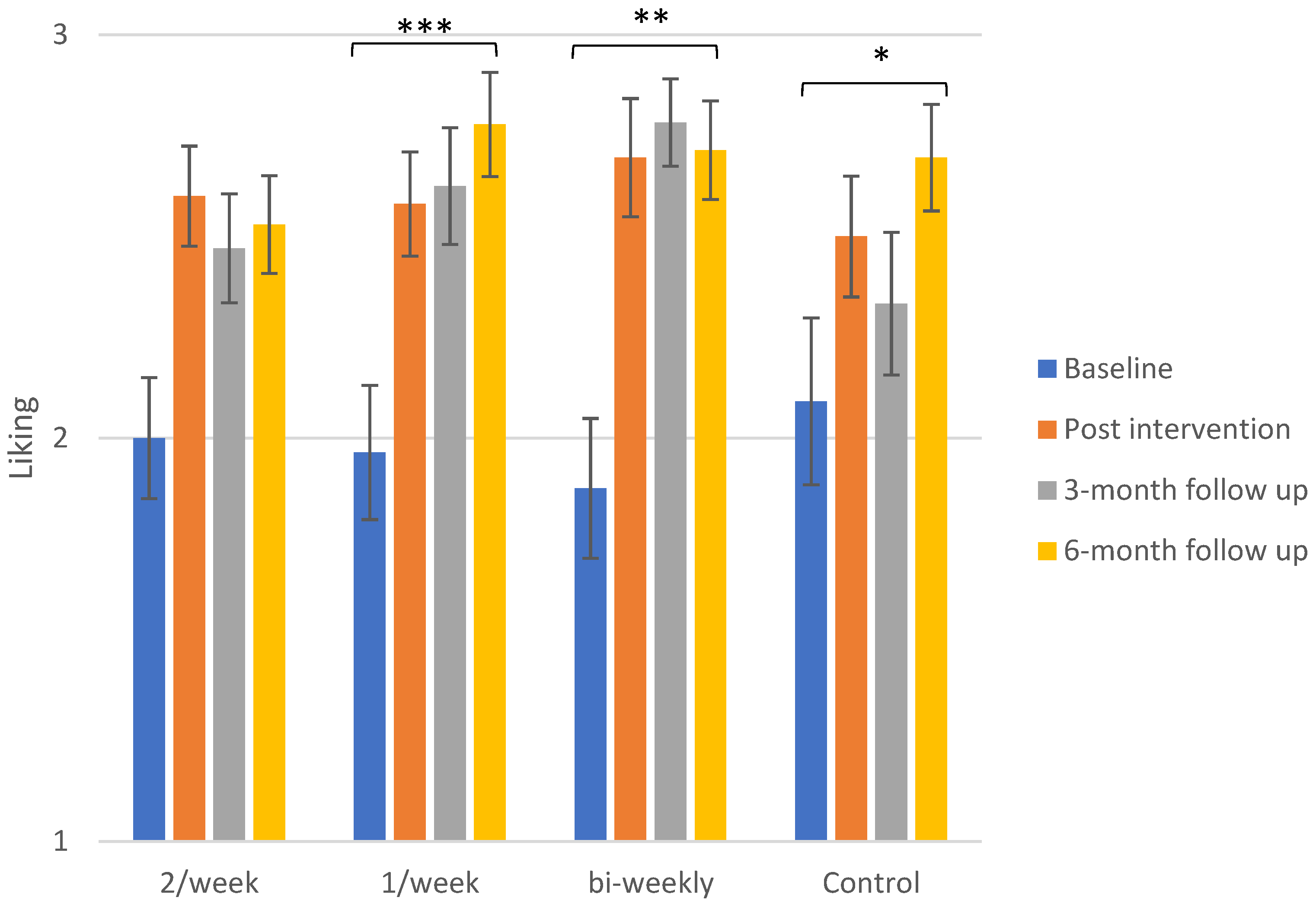
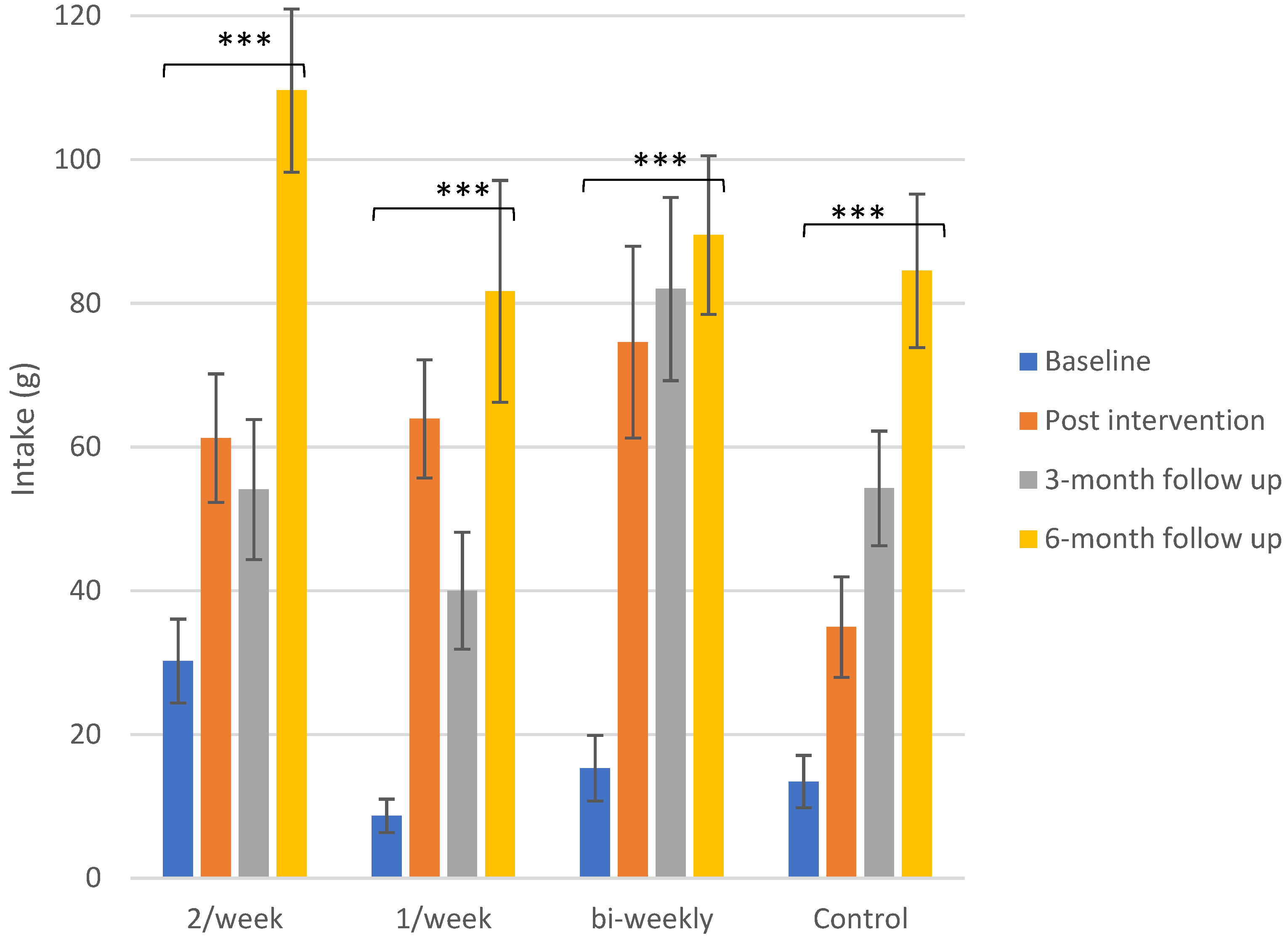
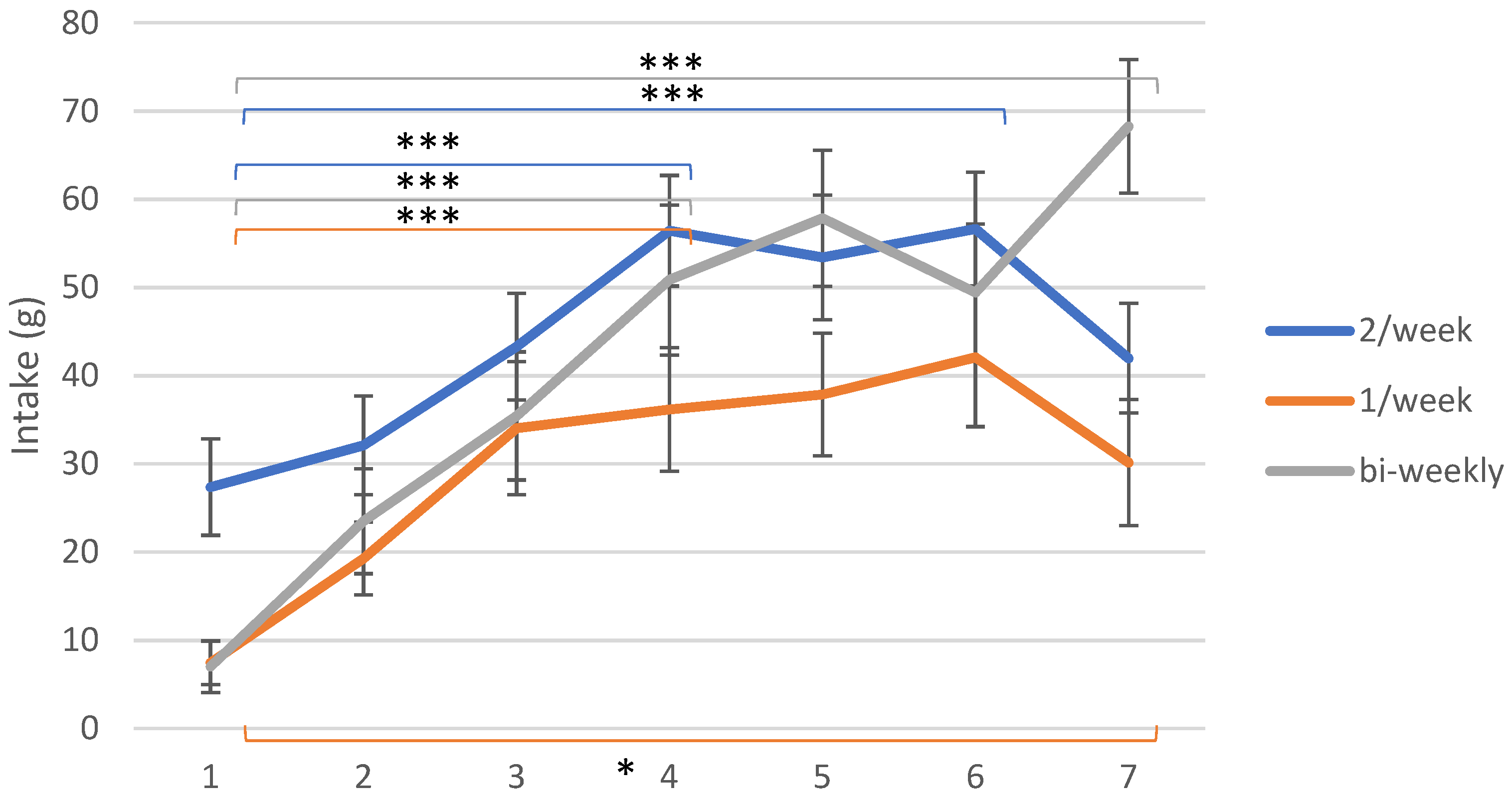
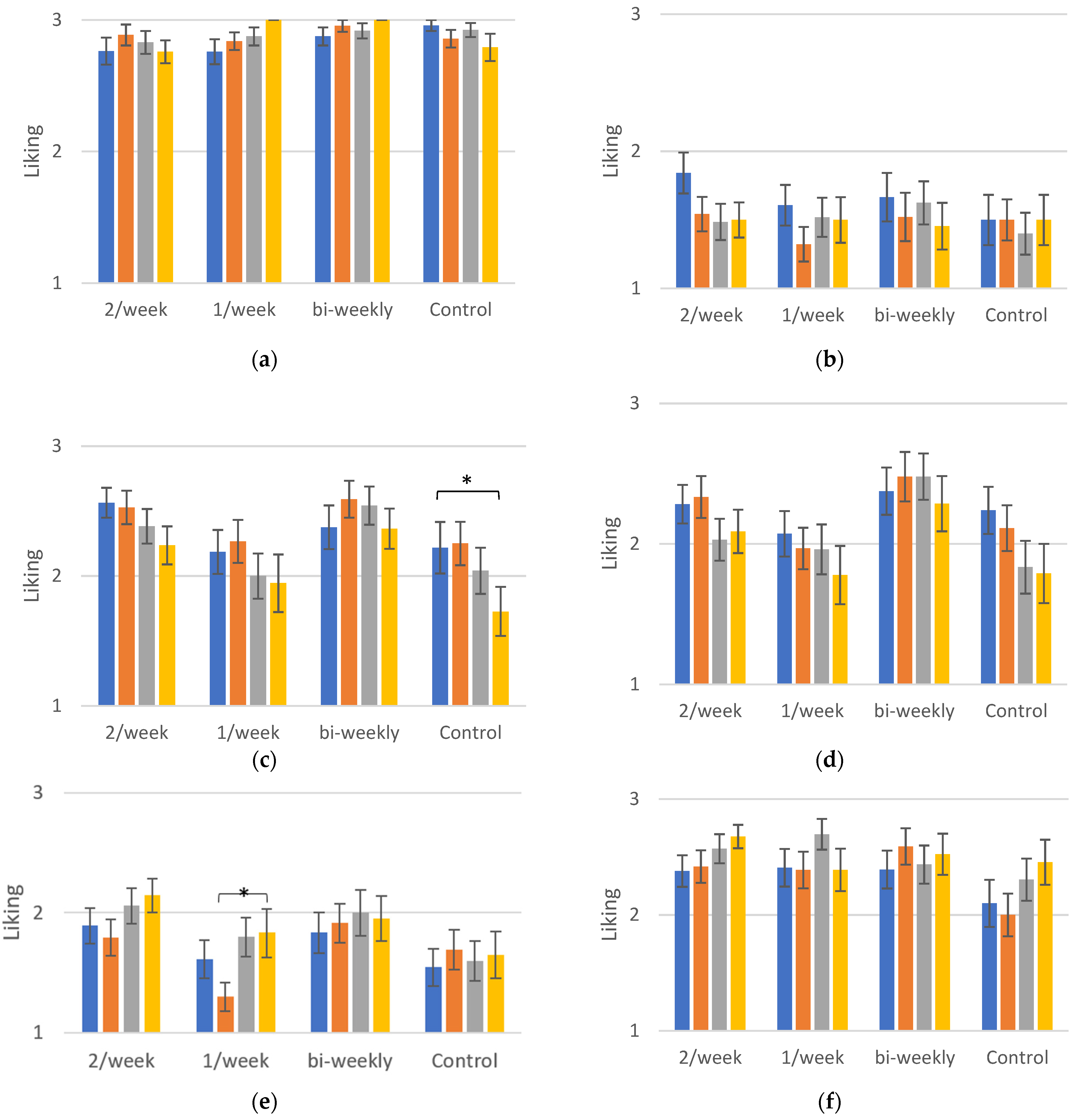
| Type of Visit | Groups | Test | Vegetable |
|---|---|---|---|
| Pre-test/baseline measurement | All | Individual testing | Familiarity and liking: Broccoli, Cauliflower, Celeriac, Daikon (round), Beetroot (round) |
| All | Intake (200 g) | Daikon, round | |
| Exposure twice a week | 2/week | Seven exposures (100 g) | Daikon, grated |
| Exposure once a week | 1/week | Seven exposures (100 g) | Daikon, grated |
| Exposure once every second week | Bi-weekly | Seven exposures (100 g) | Daikon, grated |
| Post-test | All | Intake (200 g) | Daikon, round |
| All | Individual testing | Familiarity and liking: Broccoli, Cauliflower, Celeriac, Daikon (round), Beetroot (round) | |
| 3-month follow-up | All | Intake (200 g) | Daikon, round |
| All | Individual testing | Familiarity and liking: Broccoli, Cauliflower, Celeriac, Daikon (round), Beetroot (round) | |
| 6-month follow-up | All | Intake (200 g) | Daikon, round |
| All | Individual testing | Familiarity and liking: Broccoli, Cauliflower, Celeriac, Daikon (round), Beetroot (round) |
| Control | 2/Week | 1/Week | Bi-Weekly | |
|---|---|---|---|---|
| n | 50 | 47 | 32 | 30 |
| Girls/boys | 23/27 | 30/17 | 14/18 | 15/15 |
| Age 1 ± SEM | 51.8 ± 2.0 | 55.0 ± 0.9 | 53.8 ± 2.1 | 53.8 ± 1.4 |
Publisher’s Note: MDPI stays neutral with regard to jurisdictional claims in published maps and institutional affiliations. |
© 2021 by the authors. Licensee MDPI, Basel, Switzerland. This article is an open access article distributed under the terms and conditions of the Creative Commons Attribution (CC BY) license (https://creativecommons.org/licenses/by/4.0/).
Share and Cite
Karagiannaki, K.; Ritz, C.; Jensen, L.G.H.; Tørsleff, E.H.; Møller, P.; Hausner, H.; Olsen, A. Optimising Repeated Exposure: Determining Optimal Exposure Frequency for Introducing a Novel Vegetable among Children. Foods 2021, 10, 913. https://doi.org/10.3390/foods10050913
Karagiannaki K, Ritz C, Jensen LGH, Tørsleff EH, Møller P, Hausner H, Olsen A. Optimising Repeated Exposure: Determining Optimal Exposure Frequency for Introducing a Novel Vegetable among Children. Foods. 2021; 10(5):913. https://doi.org/10.3390/foods10050913
Chicago/Turabian StyleKaragiannaki, Klelia, Christian Ritz, Louise Grønhøj Hørbye Jensen, Ellen Hyldgaard Tørsleff, Per Møller, Helene Hausner, and Annemarie Olsen. 2021. "Optimising Repeated Exposure: Determining Optimal Exposure Frequency for Introducing a Novel Vegetable among Children" Foods 10, no. 5: 913. https://doi.org/10.3390/foods10050913
APA StyleKaragiannaki, K., Ritz, C., Jensen, L. G. H., Tørsleff, E. H., Møller, P., Hausner, H., & Olsen, A. (2021). Optimising Repeated Exposure: Determining Optimal Exposure Frequency for Introducing a Novel Vegetable among Children. Foods, 10(5), 913. https://doi.org/10.3390/foods10050913





